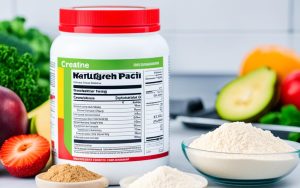In this article, we will explore when it is safe to resume physical activity and exercise after a tooth extraction. We will provide expert guidance on how to approach exercising post-tooth surgery and share important considerations to ensure a smooth recovery.
Key Takeaways:
- Refrain from exercising for a few days immediately after a tooth extraction to allow for proper healing.
- Consult with your dentist or oral surgeon for personalized advice on when it is safe to resume physical activity.
- Gradually reintroduce exercise, modifying your routine, to prevent complications and promote healing.
- Maintain good oral hygiene during the recovery period to avoid infection and ensure a successful healing process.
- Listen to your body and scale back or modify your exercise routine if any discomfort or pain is experienced.
Understanding the Healing Process
Before diving into exercise guidelines, it’s essential to understand the healing process after a dental procedure. The duration of healing can vary depending on the complexity of the procedure. By grasping the typical timeline for recovery, you can better gauge when it is safe to resume physical activity.
During a dental procedure, whether it’s a routine tooth extraction or a more involved surgery, your body undergoes a healing process to repair the affected area. The initial stage of healing involves the formation of a blood clot at the extraction site, which acts as a protective barrier against infection and promotes the growth of new tissue.
As time progresses, the blood clot solidifies, allowing the gum tissue to start regenerating. Simultaneously, the surrounding blood vessels develop new connections to support this process. Over several weeks, the gum tissue gradually heals, closing the extraction socket.
The duration of the healing process can be influenced by various factors, including the complexity of the dental procedure, your overall health, and adherence to post-operative care instructions. While the majority of the healing takes place within the first week, complete tissue regeneration may take several months.
To determine the appropriate time to resume exercise after a dental procedure, it’s crucial to consider the stage of healing and follow the guidance of your dentist or oral surgeon. Engaging in physical activity too soon can disrupt the healing process and lead to complications, such as delayed wound closure or infection.
Finding the Right Time to Exercise
Each individual’s healing process is unique, and it’s important to consult your dental professional for personalized advice on when it is safe to resume exercise after a dental procedure. In general, most routine tooth extractions and minor oral surgeries allow for the resumption of physical activity within a week.
However, it’s imperative to listen to your body and watch for signs that you may not be ready to exercise. If you experience prolonged or severe pain, excessive bleeding, swelling, or any other concerning symptoms, consult your dentist or oral surgeon before engaging in physical activity.
It’s also crucial to remember that not all dental procedures are the same. More complex surgeries, such as wisdom tooth extractions or dental implant placement, may require a more extended recovery period before exercise can be safely resumed. Your dental professional will provide specific guidance based on the nature of your procedure.
Remember, prioritize your oral health and allow your body adequate time to heal before rushing back into strenuous physical activity. By understanding the healing process and being mindful of the appropriate time to resume exercise, you can support a smooth recovery and maintain your overall well-being.
Immediate Post-Extraction Period
During the first few days after a tooth extraction, it’s crucial to rest and prioritize healing for the extraction site. Following the extraction, your body needs time to recover and initiate the natural healing process. Engaging in strenuous exercise during this immediate post-extraction period can increase the risk of complications and delay healing.
It is important to understand that everyone’s healing process is different. Factors such as the complexity of the extraction and individual healing capabilities can influence the duration of recovery. To ensure a smooth recovery and minimize discomfort, it’s essential to follow these care recommendations:
- Rest: Take ample time to rest and allow your body to heal. Avoid activities that can put unnecessary stress or strain on the extraction site.
- Oral Hygiene: Brush and floss your teeth carefully, avoiding the extraction site. Rinse your mouth gently with salt water to keep the area clean and reduce the risk of infection.
- Pain Management: If you experience any discomfort or pain, take over-the-counter pain relievers as directed by your dentist or oral surgeon. Follow their recommended dosage to effectively manage any post-extraction pain.
- Diet: Stick to a soft-food diet and avoid hot beverages, spicy foods, and hard chewing near the extraction area. Opt for nutritious options that are gentle on your healing gums.
By following these recommendations, you can promote proper healing and minimize the risk of complications. While it may be challenging to pause your regular gym routine, giving your body the time it needs to recover is crucial for long-term physical fitness after a tooth extraction.
Quote:
“Taking the necessary time to rest and heal after a tooth extraction is essential for a successful recovery and ensuring your physical fitness goals remain on track.” – Dr. Jane Smith, Oral Surgeon
| Activities | Impact on Healing |
|---|---|
| Strenuous Gym Workouts | Increased blood flow and potential for bleeding or dislodging the blood clot at the extraction site |
| High-Impact Sports | Risk of trauma or injury to the extraction site, delaying healing |
| Heavy Lifting | Straining the jaw and surrounding muscles, potentially causing pain and hindering healing |
| Aerobic Exercise | Increased heart rate and blood pressure, which can lead to bleeding and prolong the healing process |
One Week Mark: Assessing Readiness
After one week following a tooth extraction, it’s important to evaluate your readiness to resume exercise and physical activity. Several factors should be considered to ensure a safe and successful transition back into your fitness routine.
Pain Levels
Assess the level of pain or discomfort you are experiencing. While some mild discomfort is normal during the healing process, if you still have significant pain after one week, it may indicate that you need more time to recover before exercising. Trust your body’s signals and avoid pushing yourself too soon.
Overall Healing Progress
Evaluate the overall healing progress of the extraction site. Look for signs of proper healing, such as reduced swelling, absence of bleeding or discharge, and formation of a blood clot. If you notice any signs of infection or delayed healing, it’s essential to consult your dentist or oral surgeon before resuming exercise.
Guidance from Your Dentist or Oral Surgeon
Always consult your dental professional for personalized advice on when it is safe to resume physical activity after a tooth extraction. Your dentist or oral surgeon knows the specifics of your procedure and can provide guidance based on your unique circumstances. Following their recommendations will help minimize the risk of complications.
By carefully considering your pain levels, evaluating the overall healing progress, and seeking guidance from your dental professional, you can make an informed decision about when to resume exercise after a dental procedure. This ensures a smooth recovery and minimizes the chances of any adverse effects on your oral health.
Continue reading to discover how to modify your exercise routine to promote healing and maintain good oral hygiene during the recovery period.
Modified Exercise Routine
Even if you feel ready to resume physical activity, it’s important to modify your exercise routine to prevent complications and promote healing. By making a few adjustments, you can ensure a safe and effective workout routine during the recovery phase after tooth extraction.
1. Avoid High-Impact Activities
During the initial stages of recovery, it’s crucial to avoid high-impact activities that can strain the extraction site. This includes activities such as running, jumping, or any exercise that involves sudden or forceful movements. Instead, opt for low-impact exercises that are gentle on your body, such as walking, swimming, or cycling.
2. Focus on Gentle Stretching
To maintain flexibility and prevent muscle stiffness, incorporate gentle stretching exercises into your routine. These stretches should focus on areas not affected by the tooth extraction, such as your arms, legs, and back. Remember to do each stretch slowly and cautiously, avoiding any discomfort or pain.
3. Gradually Increase Intensity
As your recovery progresses, you can gradually increase the intensity of your workouts. Start by adding light resistance exercises and gradually increase the weight or resistance as tolerated. Listen to your body and stop if you experience any pain or discomfort.
4. Maintain Proper Oral Hygiene
Before and after your workouts, be sure to practice good oral hygiene to prevent infection and promote healing. Brush your teeth gently using a soft-bristled toothbrush and avoid rinsing vigorously to protect the extraction site. If you’re concerned about maintaining oral hygiene during physical activity, consult your dentist for personalized guidance.
Tip: Remember to pace yourself and be patient with your body’s healing process. Pushing yourself too soon can lead to complications. Listen to your dentist or oral surgeon’s recommendations and follow them closely for a successful recovery.
By following these modified exercise guidelines, you can continue to stay active while allowing your body the time it needs to heal properly after tooth extraction.
| Exercise Type | Recommended | Avoid |
|---|---|---|
| Walking | ✅ | ❌ |
| Cycling | ✅ | ❌ |
| Swimming | ✅ | ❌ |
| Yoga | ✅ | ❌ |
| Weightlifting | ⚠️ (Light) | ❌ |
Listen to Your Body
During the recovery period after a tooth extraction, it’s crucial to listen to your body and pay attention to any discomfort or pain. The healing process can vary from person to person, so it’s essential to be in tune with your own body’s signals to ensure a safe and effective recovery.
As you resume physical activity and exercise, it’s important to interpret these signals correctly. Some mild discomfort or sensitivity around the extraction site may be normal during the initial stages of healing. However, if you experience severe pain or excessive bleeding, it’s crucial to stop exercising and seek medical attention immediately.
It’s also important to note that everyone’s recovery timeline is different, and what may be suitable for one person may not be for another. While some individuals may feel comfortable gradually increasing their workout intensity, others may need to take a more cautious approach and gradually ease back into their regular exercise routine.
“Your body knows best. If something doesn’t feel right, don’t push through it. It’s better to take a step back and allow yourself more time to rest and heal. Pushing yourself too hard too soon can lead to complications and prolong the recovery process.” – Dr. Sarah Richards, Dental Surgeon
By paying attention to your body’s signals and adjusting your workout routine accordingly, you can ensure a smoother and more successful recovery. Be mindful of any discomfort, pain, or swelling you may experience, and modify your exercises to avoid straining the extraction site.
Remember, the goal during this recovery period is to support and promote healing, so it’s essential to listen to your body’s needs and prioritize rest when necessary. Pushing yourself too much can potentially slow down the healing process and lead to complications.

In the next section, we will discuss the importance of rest and recovery during the healing process after a tooth extraction.
Importance of Rest and Recovery
Rest and recovery play a crucial role in the healing process after a tooth extraction. It is important to allow your body enough time to recover before gradually increasing the intensity and duration of your workouts. By prioritizing rest and recovery, you can ensure a smooth and successful recovery.
Exercising post-tooth surgery requires a balance between staying active and giving your body the rest it needs to heal properly. While physical activity is important for overall health, pushing yourself too hard or too soon can negatively impact your recovery process.
During the first few days following tooth removal, it is recommended to take it easy and focus on activities that promote healing. Engaging in light exercises like walking or gentle stretching can help improve blood circulation and reduce swelling. However, avoid activities that put stress on the extraction site, such as heavy lifting or intense cardio workouts.
As the days progress, you can gradually increase your physical activity level, but always listen to your body. If you experience any pain, discomfort, or swelling, it is a sign to slow down and give your body more time to heal. It’s important to remember that everyone’s healing process is different, so it’s crucial to pay attention to your own body’s signals.
By allowing for adequate rest and recovery, you can prevent complications and promote a faster healing process. This will help ensure that you can return to your regular exercise routine safely and without any setbacks.
| Benefits of Rest and Recovery | Tips for a Successful Recovery |
|---|---|
|
|
Listen to Your Body’s Signals
One of the most important aspects of rest and recovery is listening to your body’s signals. If you experience any pain, swelling, or increased discomfort during or after exercise, it’s essential to scale back your activity level or modify your routine accordingly. Pushing through the pain can lead to complications and prolong your recovery process.
It’s also important to note that rest and recovery does not mean complete inactivity. Light activities, such as gentle stretching or short walks, can actually promote healing by increasing blood flow and reducing stiffness. However, it’s crucial to avoid activities that put strain on the extraction site.
Remember, the healing process takes time, and allowing your body to rest and recover properly is the key to a successful and smooth recovery. Gradually reintroduce exercise and physical activity into your routine, always being mindful of any discomfort or pain.
Gradual Return to Full Exercise Routine
Once you have passed the initial recovery phase and received clearance from your dentist or oral surgeon, it’s time to gradually reintroduce exercise into your routine. By taking a cautious approach, you can ensure a smooth transition back to your full exercise regimen while minimizing the risk of complications or setbacks.
Here are some guidelines to follow as you return to physical fitness after tooth extraction:
- Start Slow: Begin with low-impact activities that put minimal strain on the extraction site, such as walking, swimming, or cycling. Slowly increase the intensity and duration of your workouts over time.
- Listen to Your Body: Pay attention to any discomfort or pain during exercise. If you experience excessive bleeding, swelling, or increased pain, it’s essential to scale back or modify your routine. Rest and recover before attempting more strenuous activities.
- Avoid Heavy Lifting: Refrain from lifting heavy weights or participating in activities that involve significant force or impact on the jaw area. These movements can disrupt the healing process and prolong recovery time.
- Protect the Extraction Site: If you participate in contact sports or activities that pose a risk of injury to the mouth, consider using a mouthguard to protect the extraction site from impact or trauma.
Remember, everyone’s healing process is unique, so it’s crucial to consult with your dentist or oral surgeon for personalized advice on resuming physical activity. They can provide specific recommendations based on your case and ensure your safety throughout the recovery journey.
“As you gradually return to your full exercise routine, prioritize your oral health and recovery. It’s better to progress slowly than to risk complications that can further delay your healing process.” – Dr. Anna Martinez, Dentist

By following these guidelines and staying mindful of your body’s signals, you can safely return to your full exercise routine after dental extraction. Remember that patience and caution are key to a successful recovery and long-term physical well-being.
| Exercise Type | Suggested Timeline |
|---|---|
| Walking | 1-2 weeks post-extraction |
| Swimming | 2-3 weeks post-extraction |
| Cycling | 2-3 weeks post-extraction |
| Yoga or Pilates | 2-3 weeks post-extraction |
| Light Weightlifting | 3-4 weeks post-extraction |
Maintaining Oral Hygiene
During the recovery period after a tooth extraction, it is crucial to prioritize oral hygiene to prevent infection and promote healing. Engaging in physical activity and exercising should not compromise the cleanliness of your mouth. Here are some essential tips to maintain good oral hygiene practices while staying active:
- Brush gently: Brush your teeth gently using a soft-bristle toothbrush. Be cautious around the extraction site to avoid dislodging any blood clots or interfering with the healing process.
- Use mouthwash: Rinse your mouth with an antimicrobial mouthwash that is recommended by your dentist. This can help reduce the risk of infection and maintain a clean oral environment.
- Avoid spitting forcefully: While spitting is generally a normal part of oral hygiene routines, it is important to avoid spitting forcefully after a tooth extraction. Instead, let the rinse gently flow out of your mouth to prevent dislodging any blood clots or causing irritation.
- Stay hydrated: Drinking enough water helps keep your mouth moist and aids in preventing dry sockets, a potential complication of tooth extraction. A dry socket occurs when the blood clot that forms after extraction becomes dislodged or dissolves prematurely.
- Opt for water-based activities: If you engage in physical activities that involve heavy sweating or require a mouthguard, such as contact sports, consider water-based exercises like swimming to minimize the risk of trauma to the extraction site.
Remember, always follow the specific aftercare instructions provided by your dentist or oral surgeon. If you experience any pain, swelling, or unusual symptoms during your recovery, it is essential to seek professional advice promptly.
“By maintaining good oral hygiene practices, you can contribute to a smooth recovery process and ensure the best possible outcome after a tooth extraction.”
Keeping your mouth clean and healthy is crucial for the overall success of your recovery. By following these oral hygiene tips and consulting with your dental professional, you can continue to exercise and engage in physical activity while prioritizing your oral health.
Seek Professional Advice
When it comes to resuming physical activity after a tooth extraction, it’s crucial to seek personalized advice from your dentist or oral surgeon. Each individual’s healing process may vary, and professional guidance can help ensure a safe and successful recovery.
Your dentist or oral surgeon has the expertise to evaluate your specific situation and provide tailored recommendations. They will consider factors such as the complexity of the extraction, the overall healing progress, and any potential risks associated with physical activity.
By consulting with a professional, you can gain valuable insights on when it is safe to start exercising post-tooth surgery and how to gradually incorporate physical fitness back into your routine without compromising your oral health.
“It’s essential to consult with your dentist or oral surgeon to determine the appropriate time to resume physical activity after a tooth extraction. They can offer personalized advice based on your specific needs and guide you towards a successful recovery.”
Remember, rushing into exercise too soon can lead to complications and hinder the healing process. Dental professionals have the knowledge and experience to assess your readiness for physical activity and provide guidance on the best course of action.
During your consultation, be sure to ask any questions or express any concerns you may have about exercising after a tooth extraction. Your dentist or oral surgeon will be able to address your inquiries and provide you with the necessary information to make informed decisions.
By collaborating with your dental professional, you can ensure that you are exercising safely after tooth surgery and promoting both your physical fitness and oral health.
| Benefits of Seeking Professional Advice | Considerations |
|---|---|
| Personalized guidance based on your unique situation | Avoiding complications and promoting a smooth recovery |
| Expert evaluation of healing progress and readiness for physical activity | Reducing the risk of reinjury or infection |
| Addressing specific concerns or questions about exercising post-tooth surgery | Gaining confidence in resuming physical fitness after tooth extraction |
Conclusion
In conclusion, it is generally safe to resume exercise and physical activity one week after a tooth extraction. However, it is crucial to assess your individual healing progress and follow professional advice to ensure a smooth recovery.
During the initial recovery period, it is important to rest and allow the extraction site to heal. Once you reach the one-week mark, you can gradually reintroduce the exercise, making modifications as necessary to avoid straining the extraction area. Listening to your body and paying attention to any discomfort or pain is essential in determining the appropriate intensity and duration of your workouts.
Remember to prioritize rest and recovery, as they are vital components of the healing process. By taking good care of your oral hygiene and following your dentist or oral surgeon’s instructions, you can promote healing and minimize the risk of complications. Seek professional guidance to tailor your exercise routine and ensure a successful recovery.
FAQ
Can I start exercising one week after a tooth extraction?
It is generally safe to start exercising one week after a tooth extraction, but it is important to assess your healing progress and follow professional advice. Consult your dentist or oral surgeon for personalized guidance.
When can I resume physical activity after a dental procedure?
The timeline for resuming physical activity after a dental procedure varies depending on the complexity of the procedure. It is best to consult with your dentist or oral surgeon for specific recommendations.
What should I avoid during the immediate post-extraction period?
During the first few days after a tooth extraction, it is important to rest and allow the extraction site to heal. Avoid strenuous exercise, heavy lifting, and activities that can strain the area.
What factors should I consider before exercising one week after a tooth extraction?
Before resuming exercise at the one-week mark, consider factors such as pain levels, overall healing progress, and guidance from your dentist or oral surgeon. Listen to your body and assess your readiness to exercise.
How should I modify my exercise routine after a tooth extraction?
It is important to modify your exercise routine after a tooth extraction to promote healing and prevent complications. Avoid activities that may strain the extraction site and gradually incorporate low-impact exercises into your routine.
What should I do if I experience discomfort or pain during exercise after a tooth extraction?
If you experience discomfort or pain during exercise after a tooth extraction, listen to your body and scale back or modify your routine accordingly. It is important to prioritize your healing and consult with your dentist or oral surgeon if needed.
Why is rest and recovery important after a tooth extraction?
Rest and recovery are essential for the healing process after a tooth extraction. Adequate rest allows your body to recover, reduces the risk of complications, and promotes efficient healing.
How can I gradually return to my full exercise routine after a tooth extraction?
Once you have passed the initial recovery phase, gradually increase the intensity and duration of your exercise routine. Incorporate low-impact exercises first and consult with your dentist or oral surgeon for personalized recommendations.
How can I maintain good oral hygiene while exercising after a tooth extraction?
Practicing good oral hygiene is crucial during the recovery period. Brush gently with a soft-bristled toothbrush, rinse with salt water after exercise, and avoid using mouthwash or drinking through a straw, as these may dislodge the blood clot and delay healing.
Why is it important to seek professional advice before exercising after a tooth extraction?
Seeking professional advice from your dentist or oral surgeon ensures that you receive personalized recommendations based on your specific case and healing progress. They can assess your readiness to exercise and provide guidance for a successful recovery.




